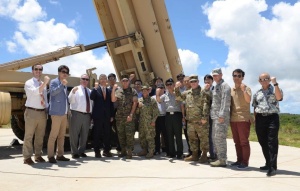Recently, U.S. Forces Korea has started to upgrade its Terminal High-Altitude Area Defense (THAAD) system deployed in Seongju, a small county about 130 miles south of Seoul, South Korea. Out of all the stated reasons for this upgrading – to protect South Korean people from North Korea’s missile threats – one statement is especially worth noting.
According to the media, South Korea’s Ministry of National Defense claimed that the upgrade would provide “better performance” by “improving interoperability” between the THAAD system and the Patriot system. (The latter has been deployed in South Korea for years.) South Korean defense officials stated that once this upgrade is completed, U.S. Forces Korea would be able to couple THAAD and the Patriot system together into a single defense system, streamlining and integrating their respective capabilities.
From a tactical standpoint, the THAAD system is designed to shoot down hostile missiles at altitudes of 40-150 kilometers, while the Patriot system, e.g., the PAC-3, is designed to intercept missiles at altitudes of 40 kilometers and lower. Both systems are designed and manufactured by U.S. defense companies Lockheed Martin and Raytheon. From a strategic view, however, upgrading the THAAD system in South Korea will not only give U.S. military forces in South Korea a more three-dimensional and complete missile defense capability but also may provide technical, political, and diplomatic references for future upgrades or even additional deployments in and/or beyond the Korean Peninsula.
Globally, as of 2019, the United States fields seven THAAD batteries and has deployed three outside of the continental United States, including in Guam, and South Korea, whereas additional radars for THAAD system are deployed in other places in Japan, Turkey, Israel, and Saudi Arabia. Recently, Lockheed Martin has received a contract totaling $74 million to produce an eighth THAAD battery for the U.S. government. People may wonder where this new battery will be deployed.
From a strategic standpoint, what’s the point of upgrading the THAAD system in South Korea at this moment? This would hardly stop North Korea’s efforts to further develop its missile capabilities, given the sustaining tension on the Korean Peninsula, especially between Pyongyang and Washington. In fact, despite the ongoing upgrades in the South, North Korea carried out multiple “countering” acts, including launching a short-range ballistic missile toward the sea between South Korea and Japan. Pyongyang has been doing this for quite a long time, and there’s no evidence to prove that North Korea would change its approach due to upgrades to the THAAD system in the South.
But maybe North Korea is not really the target.
In the Cold War era, the Jupiter Intermediate-Range Ballistic Missiles Defense system was deployed in Turkey for deterrence against the Soviet Union. It was later secretly removed by then-U.S. President John F. Kennedy at the request of Soviet leader Nikita Khrushchev in exchange for Moscow’s withdrawal of Soviet missiles deployed in Cuba. Today, despite the desire of Turkey under Recep Tayyip Erdogan to play a more active role mediating between the U.S. and Russia, we still find the U.S. THAAD system being deployed on Turkish territory, as mentioned above.
Turning to Northeast Asia, the same geopolitical logic seems to have been copied, except that the countries have been replaced with a rising China and an allied South Korea that coincidentally seeks U.S. protection against missile threats from the North.
From the very beginning of the THAAD deployment process, Beijing has been concerned that the batteries were really aimed at China. Chinese concerns are not unfounded. Referring to the U.S. official documents previously released several years ago, South Korean media underlined that the THAAD radar can be operated in two settings: terminal mode (TM) and forward-based mode (FBM), with detection ranges of 600 to 900 and 1,800 to 2,000 kilometers respectively. Switching between these two modes can be finished in 8 hours. Referring to Google Maps, the straight-line distance between Seongju, South Korea where the THAAD system is deployed and China’s capital, Beijing, is roughly 1,130 kilometers – well within THAAD’s radar range.
It is, of course, a boon for Washington to deploy and continue to upgrade the THAAD system in South Korea, especially when the relationship between China and the United States has been in an uneasy downward slide. It is even a great deal for U.S. arms dealers. For example, according to Lockheed Martin, the THAAD system alone can secure more than 18,600 jobs for Americans in 40 U.S. states, with millions of dollars in profits.
It is, however, not necessarily a happy development for Seoul in the end. It is quite clear that via the THAAD system the Americans have successfully nailed a “strategic wedge” between Seoul and Beijing by successfully exploiting the South Koreans’ security aspirations. And even the stated case for THAAD is based on the simplistic assumption that deployment makes South Koreans safer, rather than simply fostering a new phase of the inter-Korean arms race.
Is the Korean Peninsula doomed to a protracted or even permanent confrontation? If we continue to follow the logic of a zero-sum game in dealing with Korean Peninsula issues, we will find less and less momentum and space for peace and reconciliation. All parties in Northeast Asia have their own security aspirations, including Pyongyang and Beijing. The problem can only be truly solved when all parties fully consider each other’s security aspirations and seek a reasonable balance.
In this regard, a culture of “empathy diplomacy,” as suggested in my previous piece, must be built in Northeast Asia, despite the prevalence of realpolitik. As the need for a diplomatic solution to any conflict is repeatedly promoted by all sides, building a culture of empathy is by no means an empty slogan full of idealism. After all, isn’t empathy a genuinely core part of diplomacy? If not, then what is the actual point of diplomacy?

































